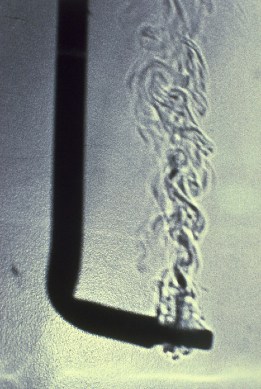| diameter lies just below the pole pieces until the visitors step on a mat-switch. Then a current of 200 amperes makes the wire pop up through the field. If one tries to push it down, one can feel the magnitude of the force. The direct current through the wire is not completely smooth so that the wire feels vibrant to a visitor when he or she touches it. When the current flows, the large rectifier lights up to indicate electricity and the required large transformer is clearly on view. However, when I first showed this exhibit to a very knowledgeable member of our graphics department she said: "The lid of my garbage also pops up when I step on a little lever". Over and over again I have watched visitors step on the mat-switch, feel the force on the wire, shrug their shoulders and move on with an expression of "so what". We do not know how to make the exhibit (and several other analogous basic electrical exhibits) more captivating, more beautiful or more instructive. The only thing that has occurred to us is to use an entirely different attack. We have built a vacuum system with a cold cathode generated electron beam that is made visible by introducing a small flow of helium into the vacuum. The beam is about 1/4" in diameter and 18" long. One can deflect it with a hand-held magnet or steer it with a joy stick connected to electrostatic deflectors. This beam, of about eight kilovolts, can be directed to turn a radiometer, to impinge on a thin foil and make it red hot, to light up a fluorescent screen or to fall on a Faraday cup that is connected to an external milliammeter. We call the exhibit "Electric Currents with the Wire Removed". We still have trouble with the stability of the focused beam, but when the beam behaves as we intend it to, the visitors are intrigued and captivated, and we often observe people explaining it to each other. The glow of the beam, the elegance of the glassware and of the internal gadgets render the exhibit really quite handsome. When its performance is debugged, it will make a very good exhibit. Sometimes we can figure out how to revive or reconstruct a dud exhibit. Our exhibit | Convection Currents provides an example. The exhibit was conceived by one of our staff members who was developing an exhibit to demonstrate that the temperature of boiling water and the steam above it remains constant no matter how fast the water boils. At one point, while heating the rectangular glass water boiler tank, he noticed the shadows of the rising hot water that were produced on a wall by a nearby clear light bulb. These convection currents shadows were worthy of a second exhibit so he made another identical tank, put a clear light bulb behind it on a long table and a frosted screen in front of it. He mounted a small helical calrod in the water. The viewer could vary the temperature of this heater and watch the convection current patterns by standing in front of the frosted screen. The exhibit worked, but it was extremely | ||
 | |||
Convection currents rise from a heated tip immersed in a thin water tenk. The currents are made visible by the shadows they cas from a very bright, yet small-sized, lamp. | |||